From employee retention to lower operational costs, sustainable facility choices are a win.
Are you working toward a more sustainable building? Maybe you have a sustainability initiative, or a goal to earn LEED certification. Whatever the case, you’re aiming for a more efficient facility.
Today, we’re sharing some inspiration. These five buildings are working to become more sustainable and improve their carbon footprint.
In a 2018 survey by CBRE, 11.5% of all buildings surveyed were Energy Star labeled and 5.2% were LEED (Leadership in Energy and Environmental Design) certified. These numbers are at an all-time high and are steadily rising.
Building operators are choosing to reduce their impact on the environment for a number of reasons. It reduces the cost to operate the building, reduces maintenance costs, contributes to a healthier workplace, and increases competitive advantages.
Your choice is clear. Move forward to a more sustainable building, or be left behind.
Five Facilities Leading the Way
Amazon
Location: Arlington, VA
Sustainability Initiatives:
- Installed all-electric central heating and cooling systems.
- Uses solar power for 100% renewable energy.
- Used locally sourced building materials to reduce carbon impact.
- Maintains efficient lighting systems.
Certification? The buildings are designed to achieve LEED v4 Platinum certification.
Impact: Amazon conducted an in-depth study in 2020 to examine their energy intensity and carbon output. Through this study, they were able to identify where they can reduce energy usage and their carbon footprint. They have created an Amazon Climate Pledge with the goal of getting to net zero by 2040.
Genzyme Center
Location: Cambridge, MA
Sustainability Initiatives:
- Utilized strategic location planning, choosing a brownfield site to reduce further degradation of the environment.
- Repurposed a nearby power plant’s “waste” steam by piping it to the building’s HVAC system.
- Proximity of the building to mass transit resulted in 25% of the building’s occupants leaving their cars at home, reducing carbon output.
- Installed a building automation system (BAS) to reduce operational and energy costs and maximize the use of natural energy sources.
Certification? Yes, LEED Platinum certification.
Impact: Genzyme’s choices have led to 42% less energy usage and 34% less water usage than standard buildings of the same size. Employees also take fewer sick days than they did in their previous building, reducing sick day use by 5%. And 58% of employees reported feeling more productive than in their previous building.
PNC Financial Services Group
Location: Cambridge, MA
Sustainability Initiatives:
- Plans include constructing 200 sustainable bank branches, which take 45 less days to construct than their traditional branches and cost $100,000 less.
- Already established branches are being retrofitted with energy efficiency and carbon reduction initiatives.
- Added building automation systems (BASs) to minimize their energy and gas consumption.
- Designed an open airy layout to improve airflow.
Certification? Yes, LEED Platinum certification.
Impact: PNC saw numerous benefits with its sustainability initiatives. First, PNC reduced energy consumption and carbon emissions by 30%. They did this by updating lighting, improving HVAC sizing, and consistently monitoring energy data. Second, PNC found that their employees’ morale improved as a result of the initiative. A study found that retention and satisfaction improved compared to employees at the traditional branches. An added benefit was that building operating costs were reduced by 35%.
Best Buy
Location: Richfield, MN
Sustainability Initiatives:
- Retrofitted 100-plus existing stores with sustainability initiatives including lighting and using Energy Star appliances.
- Newly constructed retail stores are built with the U.S. Green Building Council for LEED certification.
- Added skylights equipped with sensors that turn off overhead lighting when the sunlight is adequate.
- Added censored lighting that turns on when it senses movement.
- Installed an energy management system at its “big box” stores to centrally control temperature and lighting across all retail stores.
Certification? Yes - LEED
Impact: In 2010, Best Buy chose to address its carbon footprint throughout its network of retail stores, distribution centers, and data centers. Since then, it has reduced its emissions by 26%.
Kohl’s
Location: Menomonee Falls, WI
Sustainability Initiatives:
- Installed energy-efficient HVAC and lighting systems.
- Added reflective roofs to offset the urban heat island effect.
- Replaced fixtures with low-flow water fixtures.
- New construction materials are 20% recycled.
- Waste stream reduction across retail sites led to the recycling of 83% of all operational waste.
- Renovations to existing stores are done with the U.S. Green Building Council’s Volume Existing Building Operations and Management pilot program.
Certification? In total, 433 stores are LEED certified.
Impact: The triple bottom line (profit, people, planet) initiatives have led to overall benefits for both employees and the building operators. First, an employee survey showed that worker satisfaction has improved. Second, operating costs are improving. Third, they have seen an annual reduction in energy spending by $10,000. Fourth, they have now converted 35,616,240 square feet of retail space into LEED-certified space.
Next Steps to Operational Efficiency
While these businesses vary in industry and location, they do have one thing in common. They all agree that conserving the environment is a priority. In a large facility, small changes can have a bigger impact than you might realize.
The companies we profiled today not only lessened their impact on the environment, they also saw improved employee morale and retention and lowered operating costs.
Sustainability is a win-win for facilities and the environment alike.
Do you want to learn how Encompass can help you reach your sustainability goals? Schedule a call









